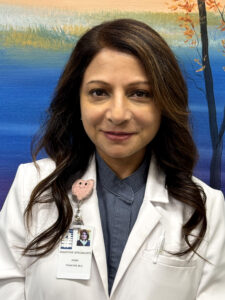 Ohio University student Madi Brown leads an active lifestyle. She stays busy studying communications, working in tourism and caring for her cherished 10-year-old beagle mix, Smoke.
Ohio University student Madi Brown leads an active lifestyle. She stays busy studying communications, working in tourism and caring for her cherished 10-year-old beagle mix, Smoke.
Behind her bright smile and cheerful outlook lives a story of resilience. Growing up, Brown faced chronic health challenges, including autoimmune disorders and irritable bowel syndrome (IBS).
This past spring, Brown, 21, started vomiting unexplainably and for extended periods of time. Her doctors proposed causes like stress, a virus or even food sensitivities but offered no definitive diagnosis.
“They tested me for everything. I did so much blood work, but nobody could really figure out why I was throwing up,” she said.
Doctor Recommends GI Procedure for Diagnosis
 After months of uncertainty about her health, Brown scheduled a visit with her board-certified gastroenterologist and AMSURG partner physician Jigna Thakore, M.D.
After months of uncertainty about her health, Brown scheduled a visit with her board-certified gastroenterologist and AMSURG partner physician Jigna Thakore, M.D.
“When she came in May, she was having a lot of nausea, vomiting, heartburn-type symptoms and just pain in her upper abdomen,” Dr. Thakore said. “We needed to figure out whether it was food allergy related versus acid reflux, versus if there’s an infection in her stomach, a gluten allergy.”
Brown underwent an ultrasound and a HIDA (hepatobiliary iminodiacetic acid) scan to evaluate her gallbladder and bile duct function. Her results were normal.
To diagnose other conditions of the upper digestive tract, Dr. Thakore recommended Brown undergo an esophagogastroduodenoscopy or EGD.
“There’s no CT scan or ultrasound or MRI or any imaging test that can give you the same information as an EGD for the upper gastrointestinal tract because it’s a camera inside you. It’s physically helping us see the actual tissue,” Dr. Thakore said. “When the imaging test is done, it shows pictures in shades of gray. Whereas with the EGD, we see the tissue and can biopsy it to test its health.”
Brown scheduled the procedure at Digestive Endoscopy Center, an AMSURG ambulatory surgery center (ASC) near her parents’ Dayton home. Although anxious about her initial endoscopy, Brown said the medical team detailed the process and offered encouragement.

During Brown’s sedation, Dr. Thakore used a slender, flexible instrument known as an endoscope to inspect the lining of her esophagus, stomach and the upper section of the small intestine.
Biopsies of the esophagus revealed gastritis, indicating inflammation in the lining of the stomach.
“The biopsies didn’t show any infection, so that would show that that’s all acid related,” Dr. Thakore said. “Biopsies in the small intestine were negative for gluten allergy or celiac disease. So, we’ve been working on her acid-related symptoms as the cause of what she was experiencing.”
Dr. Thakore also discovered a minor hiatal hernia, where Brown’s stomach extends slightly into her chest area.
“By itself, it’s not dangerous, especially when it is small, but she will have more reflux from it,” Dr. Thakore said. “That is part of her issue with nausea, vomiting.”
To heal Brown’s gastritis and lower her stomach acid would take about five to six weeks. Dr. Thakore prescribed medications for heartburn and nausea for her to take as needed until her next appointment.
Managing IBS Symptoms; Improving Gut Health
IBS affects up to 45 million Americans like Brown, who endure frequent stomach pain with diarrhea, constipation or both. To reduce IBS symptoms, Dr. Thakore recommended Brown focus on improving her gut health.
“Often, these symptoms can be improved, and these conditions can be improved with fiber alone,” Dr. Thakore said. “Over-the-counter fiber, such as psyllium husk or guar gum, … or even a high-fiber diet is helpful. Up to 20 to 30 grams of fiber a day is what the gut bacteria need to do their job.”
Gut bacteria (microbiomes) reside in the gastrointestinal tract. They assist the body with digestion, nutrient production, immune system regulation, metabolic health and more.

Dr. Thakore praised Brown for prioritizing her health for a better quality of life.
“Madi’s a fantastic, bright young lady, and I’m so proud of her for reaching out and not ignoring her symptoms,” she said. “It’s good for her to come in and work with us. And as a team, we can get her better.”
ASCs Prioritize Patient Care
AMSURG ambulatory surgery centers offer patients same-day procedures using advanced technology in a comfortable setting with shorter waiting times, often at lower out-of-pocket costs. Patients have the convenience of recovering at home.
“This is a teamwork effort. We are very fortunate to have a fantastic staff,” Dr. Thakore said. “There’s just a culture of the patient coming first and making [them] better. That’s why we exist. So, that’s what we carry through.”
Following her positive experience, Brown said she would recommend ASCs to others.

Doctors determine whether patients are suitable for outpatient surgery based on their age, existing medical conditions and the support they receive at home.
“If you’re safe enough to have an outpatient procedure, that’s the best option,” Dr. Thakore said. “We’re very timely; we’re efficient.”
About AMSURG
AMSURG is an independent leader in ambulatory surgery center services, operating a network of more than 250 surgery centers nationwide. In partnership with physicians and health systems, the organization delivers high-quality patient care across a diverse spectrum of medical specialties, including gastroenterology, ophthalmology and orthopedics. Guided by its core values — Care Deeply, Champion Excellence, Cultivate Integrity and Celebrate Teamwork — AMSURG is committed to transforming the future of ambulatory surgery center care and services with a focus on strategic growth and innovation. To learn more about AMSURG, visit www.amsurg.com.
This article is designed for educational purposes only. The information provided should not be used for diagnosing or treating a health concern or disease. It is not a substitute for professional care. If you have or suspect you may have a health concern, you should consult your healthcare provider.
